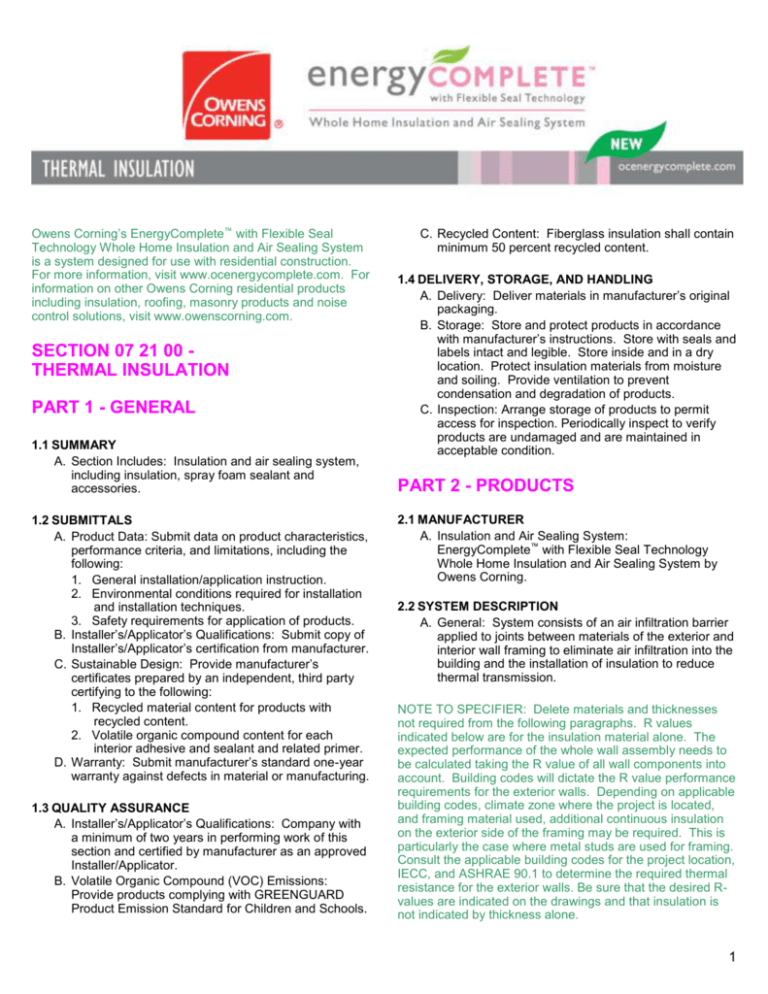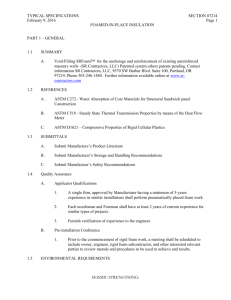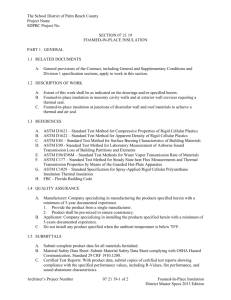
Owens Corning’s EnergyComplete™ with Flexible Seal
Technology Whole Home Insulation and Air Sealing System
is a system designed for use with residential construction.
For more information, visit www.ocenergycomplete.com. For
information on other Owens Corning residential products
including insulation, roofing, masonry products and noise
control solutions, visit www.owenscorning.com.
SECTION 07 21 00 THERMAL INSULATION
PART 1 - GENERAL
1.1 SUMMARY
A. Section Includes: Insulation and air sealing system,
including insulation, spray foam sealant and
accessories.
1.2 SUBMITTALS
A. Product Data: Submit data on product characteristics,
performance criteria, and limitations, including the
following:
1. General installation/application instruction.
2. Environmental conditions required for installation
and installation techniques.
3. Safety requirements for application of products.
B. Installer’s/Applicator’s Qualifications: Submit copy of
Installer’s/Applicator’s certification from manufacturer.
C. Sustainable Design: Provide manufacturer’s
certificates prepared by an independent, third party
certifying to the following:
1. Recycled material content for products with
recycled content.
2. Volatile organic compound content for each
interior adhesive and sealant and related primer.
D. Warranty: Submit manufacturer’s standard one-year
warranty against defects in material or manufacturing.
1.3 QUALITY ASSURANCE
A. Installer’s/Applicator’s Qualifications: Company with
a minimum of two years in performing work of this
section and certified by manufacturer as an approved
Installer/Applicator.
B. Volatile Organic Compound (VOC) Emissions:
Provide products complying with GREENGUARD
Product Emission Standard for Children and Schools.
C. Recycled Content: Fiberglass insulation shall contain
minimum 50 percent recycled content.
1.4 DELIVERY, STORAGE, AND HANDLING
A. Delivery: Deliver materials in manufacturer’s original
packaging.
B. Storage: Store and protect products in accordance
with manufacturer’s instructions. Store with seals and
labels intact and legible. Store inside and in a dry
location. Protect insulation materials from moisture
and soiling. Provide ventilation to prevent
condensation and degradation of products.
C. Inspection: Arrange storage of products to permit
access for inspection. Periodically inspect to verify
products are undamaged and are maintained in
acceptable condition.
PART 2 - PRODUCTS
2.1 MANUFACTURER
A. Insulation and Air Sealing System:
EnergyComplete™ with Flexible Seal Technology
Whole Home Insulation and Air Sealing System by
Owens Corning.
2.2 SYSTEM DESCRIPTION
A. General: System consists of an air infiltration barrier
applied to joints between materials of the exterior and
interior wall framing to eliminate air infiltration into the
building and the installation of insulation to reduce
thermal transmission.
NOTE TO SPECIFIER: Delete materials and thicknesses
not required from the following paragraphs. R values
indicated below are for the insulation material alone. The
expected performance of the whole wall assembly needs to
be calculated taking the R value of all wall components into
account. Building codes will dictate the R value performance
requirements for the exterior walls. Depending on applicable
building codes, climate zone where the project is located,
and framing material used, additional continuous insulation
on the exterior side of the framing may be required. This is
particularly the case where metal studs are used for framing.
Consult the applicable building codes for the project location,
IECC, and ASHRAE 90.1 to determine the required thermal
resistance for the exterior walls. Be sure that the desired Rvalues are indicated on the drawings and that insulation is
not indicated by thickness alone.
1
ocenergycomplete.com
2.3 MATERIALS
A. Glass-Fiber Loose-Fill Insulation: Maximum flamespread and smoke-developed indexes of 5, per
ASTM E 84 and as follows:
1. ASTM C 764, Type I for pneumatic applications.
2. ASTM C 764, Type II for poured applications.
3. Minimum R-Value, Cavity Depth 3-1/2 Inches:
R-14, (1.3 pcf density).
4. Minimum R-Value, Cavity Depth 3-1/2 Inches:
R-16, (2.5 pcf density).
5. Minimum R-Value, Cavity Depth 5-1/2 Inches:
R-22, (1.3 pcf density).
6. Minimum R-Value, Cavity Depth 5-1/2 Inches:
R-24, (2.3 pcf density).
7. Minimum R-Value, Cavity Depth 7-1/4 Inches:
R-30, (1.4 pcf density).
8. Minimum R-Value, Cavity Depth 7-1/4 Inches:
R-32, (2.4 pcf density).
9. Minimum R-Value, Cavity Depth 9-1/4 Inches:
R-38, (1.4 pcf density).
10. Minimum R-Value, Cavity Depth 9-1/4 Inches:
R-41, (2.4 pcf density).
11. Minimum R-Value, Cavity Depth 11-1/4 Inches:
R-46, (1.4 pcf density).
12. Minimum R-Value, Cavity Depth 11-1/4 Inches:
R-50, (2.4 pcf density).
B. Batt Insulation:
1. Batt Insulation, Unfaced: ASTM C 665, Type I,
preformed glass fiber batt type, unfaced.
2. Batt Insulation, Kraft Faced: ASTM C 665, Type
II, Class C preformed glass fiber batt type, Kraft
paper faced one side.
3. Batt Insulation, Foil Faced: ASTM C 665, Type II,
Class B preformed glass fiber batt type, foil faced
one side with maximum flame/smoke properties
of 75/450 in accordance with ASTM E84.
4. Minimum R-Value, Thickness 3-1/2 Inches: R-11.
5. Minimum R-Value, Thickness 3-1/2 Inches: R-13.
6. Minimum R-Value, Thickness 3-1/2 Inches: R-15.
7. Minimum R-Value, Thickness 5-1/2 Inches:
R-21.5.
8. Minimum R-Value, Thickness 5-1/2 Inches: R-18,
using R-19 6-1/4 inch batt compressed.
9. Minimum R-Value, Thickness 7-1/4 Inches: R-24,
using R-25 8 inch batt compressed.
10. Minimum R-Value, Thickness, 7-1/4 Inches:
R-28, using R-30C 8-1/2 inch batt compressed.
11. Minimum R-Value, Thickness 9-1/4 Inches:
R-29, using R-30 10 inch batt compressed.
12. Minimum R-Value, Thickness 9-1/4 Inches:
R-36, using R-38C 10 inch batt compressed.
13. Minimum R-Value, Thickness 11-1/4 Inches:
R-37, using R-38 12 inch batt compressed.
14. Thermal Resistance: As indicated on the
Drawings.
15. Batt Size: Friction fit of sizes to fit stud spacing.
C. Spray Foam Sealant:
1. Material: High-efficiency spray-applied foam.
2. Water Vapor Permeance:
a. ASTM E 96 (dry cup): Greater than 2 perm.
b. ASTM E 96 (wet cup): Greater than 30 perm
3. Dimensional Stability: ASTM D 2126, maximum
1.0% linear change at -40ºF, ambient RH after 2
weeks max 2.0% linear change at 100ºF, 97%
RH after 2 weeks.
4. Durability: ASTM C 719, more than10 cycles; no
cohesive failure or cracking.
5. Flame Spread: ASTM E 84, Less than 25.
6. Smoke Developed: ASTM E 84, Less than 450.
7. Tack-Free: Dry to the touch within 20 minutes.
8. Pressure Build: AAMA 812, less than 0.1 psi.
9. Leakage Rate: ASTM E 283, less than 0.01
cfm/ft.2 at 1.57 psf (75 Pa) and 6.24 psf (300 Pa)
pressure.
10. Fire Blocking performance: ASTM E814, pass
D. Vapor Retarders: Comply with requirements of
Section 07 26 00 “Vapor Retarders.”
E. Air Barriers: Comply with requirements of Section 07
27 00 “Air Barriers.”
2.4 ACCESSORIES
A. Accessories: Provide accessories per insulating
system manufacturer’s recommendations, including
the following:
1. Tape: Polyethylene self-adhering type for Kraft
faced insulation and bright aluminum selfadhering type for foil faced insulation.
2. Insulation Fasteners: Impale clip of galvanized
steel; type recommended by insulation
manufacturer for particular use intended.
3. Mechanical Insulation Fasteners: FM approved,
corrosion resistant, size required to suit
application.
4. Wire Mesh: Galvanized steel, hexagonal wire
mesh.
5. Spindle Fasteners: Corrosion-resistant wire
spindles.
6. Ventilation Baffles: Formed plastic, metal, or
cardboard sized to fit full width of rafter spaces.
PART 3 - EXECUTION
NOTE TO SPECIFIER: Delete installation of materials not
required from the following paragraphs. Delete paragraphs
on installation of vapor retarders and air barriers if not the
work of this Section.
3.1 EXAMINATION
A. Examine substrates, flashing conditions,
penetrations, adjoining construction and the
conditions under which work is to be installed. Verify
that surfaces are dry and free of oil, grease, dust,
rust, or other contaminant.
B. Report unacceptable conditions in writing. Do not
proceed with the Work until unsatisfactory conditions
have been corrected and surfaces are acceptable.
2
ocenergycomplete.com
D. Verify that fire stopping is in place before beginning to
apply the air infiltration barrier with flexible seal
technology.
E. Verify the following conditions have been sealed with
the air infiltration barrier before installing insulation
and before closing in framing cavities:
1. Gaps between window units and framing.
2. Gaps between door heads, jambs, and sills and
wall framing.
3. Interface of foundation or slab and sill plate.
4. Interface of band joists or rim joists and plates
and subfloor.
5. Duct shafts, utility penetrations, knee walls and
flue shafts opening to exterior or unconditioned
space.
F. Verify the following work is complete before installing
insulation and before closing in framing cavities:
1. Vapor retarder or air barrier is installed at
fireplace walls.
2. Air sealing is provided between the garage and
conditioned spaces.
3. Vapor retarder or air barrier is installed in
common walls between dwelling units.
4. Recessed light fixtures are air tight, IC rated, and
sealed to gypsum board.
a. Exception: Light fixtures in locations with
conditioned spaces on both sides do not need
to be air tight and do not need to be sealed
unless required by another Section in the
Project Manual.
3.2. PREPARATION
A. Before beginning work, protect windows, plumbing
fixtures, finish materials, and finish surfaces within
work area from overspray by covering them with a
plastic film. Secure edges of film to assure air
infiltration barrier with flexible seal technology does
not get behind the film.
B. Sweep area to receive air infiltration barrier
application to remove dust and other contaminants
that will interfere with providing a thorough seal.
C. Fill medium-sized gaps (gaps between 3/8 inch and 3
inches) between surfaces to be sprayed with
fiberglass insulation. Cover gaps greater than 3
inches with rigid, nonporous material such as gypsum
board, , extruded polystyrene insulation, sheathing,
OSB, particle board, agrifiber particle board, or
plywood secured to framing and apply sealant at the
perimeter.
D. To protect and prevent materials from sticking to eyes
and skin when applying spray-applied materials
wear, goggles or a face shield, a long sleeved shirt,
chemical gloves and, if the installation site is dusty, a
dust mask.
E. If using products other than EnergyComplete™ Air
Infiltration Barrier with Flexible Seal Technology that
may contain isocyanates, comply fully with OSHA
regulations regarding protective clothing, breathing
apparatus, ventilation, and restricting access to areas
of application.
3.3 INSTALLATION OF FOAM SEALANT
A. Spray-apply foam sealant in accordance with
manufacturer’s instruction, including compliance with
instructions for safety, preparation, and application of
products. Apply continuously and evenly to joints in
the following conditions:
1. At penetrations between conditioned and
unconditioned spaces.
2. At interface between the sheathing and stud
where a sheathing seam is known to exist.
3. At the interface between windows/doors and the
framed opening.
4. On the face of all top plates of exterior walls.
5. On the face of all top plates of interior walls
adjacent to the unconditioned attic space.
6. At interface between the sill plate and foundation.
7. At interface between the bottom plate and the
sheathing.
8. At interface between the top plate and the
sheathing.
9. At interface between the bottom plate and the
subfloor or slab for first floor of slab-on-grade
construction.
10. At any horizontal, mid-cavity sheathing seams.
11. At garage-to-house common wall.
12. At wall behind fireplace (block and seal).
13. At joist bays connecting exterior to conditioned
space, such as at garage, porch, or overhang
(block and seal).
14. At attic knee-walls (block and seal).
15. At insulated floor of room above unconditioned
space.
16. At interface between the band joist and the plate
below it.
17. At interface between the band joist and the
subfloor above it.
18. At joist bays beneath cantilevered floors, such as
for bay windows.
C. Spray Sealant is recognized in ICC-ES report ESR3110 as an alternative to the methods prescribed by
the code for maintaining the integrity of penetrations
of fireblocking when used to fill cracks and voids in
construction and the annular space created by the
penetration of wood fireblocking by pipes and
conduits.
D. Spray those gaps and penetrations filled with loose fill
insulation during preparation and thoroughly cover
them with spray foam.
E. Do not install foam sealant within 3 inches of a heat
source with exception of recessed light fixtures, which
may be sealed at the interface with the drywall.
F. Do not allow excessive overspray.
3
ocenergycomplete.com
3.4 INSTALLATION OF INSULATION, GENERAL
A. Install insulation system according to manufacturer’s
instructions, including compliance with instructions for
safety, preparation, and application of products.
B. Comply with local code requirements, and 2009 IECC
requirements indicated on Table 402.4.2 Air Barrier
and Insulation Inspection Component Criteria.
C. Do not install insulation on top of or within 3 inches of
recessed light fixtures unless the fixtures are
approved for such use.
D. Install exterior thermal envelope insulation for framed
walls in substantial contact and in continuous
alignment with building envelope vapor retarder or air
barrier.
E. Install vapor retarder air barrier in dropped ceilings
and soffits in substantial alignment with insulation.
F. Install insulation at band joists or rim joists.
G. In crawl spaces and where the underside of floors are
exposed to unconditioned space, insulation should fill
the cavity or be installed in contact with the underside
of the decking. If vapor retarder is required by local
code, a Kraft vapor retarder must be in contact with a
15 minute thermal barrier. Placement of vapor
retarder to be determined by local jurisdiction.
H. Within exterior wall framing, install insulation between
pipes and backside of sheathing. Cut insulation
material as required to fit around wiring and plumbing.
I. Where showers and bath tubs are located on exterior
walls, install insulation and vapor retarder air barrier
between units and exterior.
3.5 INSTALLATION OF LOOSE FILL INSULATION
A. Install loose fill insulation in accordance with ASTM C
1015.
B. Install to uniform, level thickness. Do not compact.
3.6 INSTALLATION OF BATT INSULATION
A. Install batt insulation in accordance with ASTM C
1320.
B. If eave ventilation baffles are required, install
ventilation baffles at eaves to hold insulation down
from roof sheathing and provide positive ventilation
from eave to attic space.
C. Install in exterior walls, roof and ceiling spaces
without gaps or voids. Fluff insulation to full thickness
for specified R-value before installation. Do not
compress insulation.
D. Trim insulation neatly to fit spaces. Insulate
miscellaneous gaps and voids.
E. Fit insulation tight in spaces and tight to exterior side
of mechanical and electrical services within the plane
of insulation.
F. For unfaced batt insulation, install with friction fit or
retain in place with manufacturer’s recommended
fasteners or mesh.
G. For batt insulation with factory-applied facing, install
with vapor retarder membrane facing warm side of
building spaces. Lap ends and side flanges of
membrane over or between framing members. Tape
seal butt ends, lapped flanges, and tears or cuts in
membrane. Secure insulation in place using one of
the following methods:
1. Friction fit.
2. Staple or nail facing flanges in place as needed.
3. Tape in place.
4. Retain in place with spindle fasteners.
5. Retain in place with wire mesh secured to
framing members.
3.7 INSTALLATION OF SEPARATE VAPOR RETARDER
A. Vapor Retarder Installation:
1. For wood framing, place vapor retarder on warm
side of insulation by stapling or nailing 6 inches
on center. Lap and seal joints over member face.
2. For metal framing, place vapor retarder on warm
side of insulation; lap and seal joints over
member face.
3. Place fasteners at manufacturer’s recommended
spacing. Tape seal tears or cuts.
4. Extend tight to full perimeter of adjacent window
and door frames and other items interrupting the
plane of membrane. Tape seal in place.
B. Vapor Retarder Installation: Comply with
requirements of Section 07 26 00 “Vapor Retarders.”
3.7 CLEANING
A. Remove protective plastic film coverings from
adjacent materials.
B. Clean unintended overspray from materials,
equipment, and fixtures.
C. Remove damaged materials, equipment, and fixtures
if overspray cannot be cleaned without blemish and
install new materials, equipment, and fixtures
identical to item before damage occurred.
D. Remove waste materials and recycle empty
containers and packaging.
Pub. No. 10013129. Printed in U.S.A. October 2010. All Rights Reserved. ©2010 Owens Corning.
4








